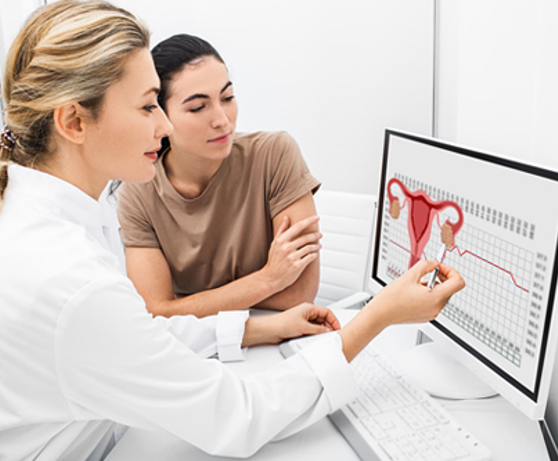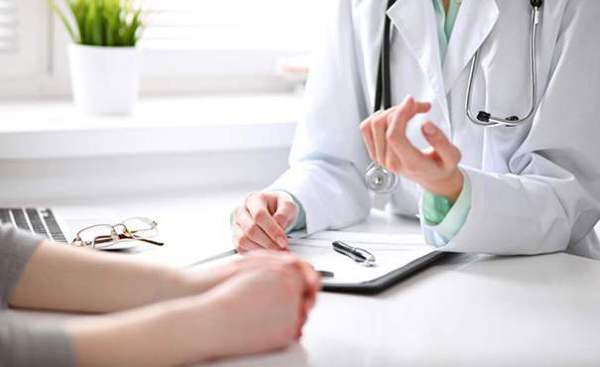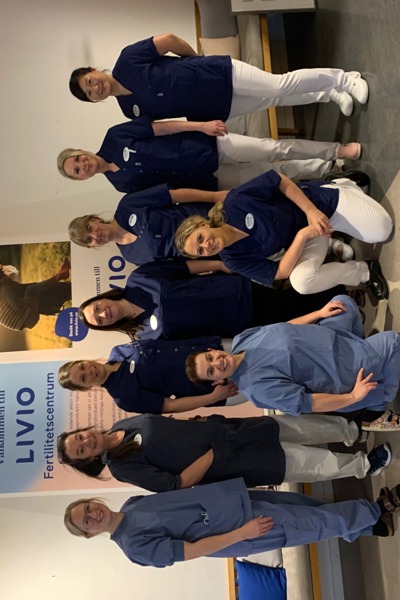Stimulation of Ovulation Treatment
Ovulation stimulation can increase your chances of becoming pregnant. For some, irregular or absent ovulation can be addressed through changes in lifestyle and diet. When these measures are not sufficient, we use proven medications to regulate hormone levels in the blood and induce ovulation, which increases your chances of having a child.

What is Stimulation of Ovulation
If the woman has infrequent or absent ovulations, ovulation can be stimulated through tablet treatment or hormone injections. This way, there are good chances for the couple to achieve their longed-for pregnancy "on their own". The stimulations can be repeated several times to increase the chance of becoming pregnant. If pregnancy still does not occur, IVF is a possible next step.
Who is it for?
If the woman has infrequent or absent ovulations, ovulation can be stimulated through tablet treatment or hormone injections. This way, there are good chances for the couple to achieve their desired pregnancy "on their own." The stimulations can be repeated several times to increase the chance of becoming pregnant. If pregnancy still does not occur, IVF is a possible next step.
What are the benefits of Stimulation of Ovulation?
The advantages of starting one's fertility journey with ovulation stimulation is that it is a less invasive and more time- and cost-effective treatment compared to more complex procedures such as IVF. By stimulating the ovaries to produce more eggs, it increases the chances of successful fertilization and treats ovulation disorders such as PCOS. The treatment is adaptable, minimally invasive, and more cost-effective compared to complex procedures like IVF. Your doctor can closely monitor the menstrual cycle, control the timing of ovulation, and reduce the risk of multiple pregnancies.
Your Stimulation of Ovulation Journey: step-by-step
Tablets are usually tried first, as it is the simplest form of treatment.

Medication
If the patient has no menstruation at all or very rarely, a menstruation-like bleeding is first initiated. This is usually done with a progesterone-like preparation, Provera (medroxyprogesterone), taken as tablets, 10 mg daily for 7-10 days. A few days after the end of medication, bleeding will occur.

Dosage
The stimulation tablets are usually given at 2.5 mg from day 3 to day 7.

Ultrasound Examination
An ultrasound examination is usually done in the first cycle around day 13. It is then seen if a larger follicle has developed and if the uterine lining has thickened. The cervical secretion can also be assessed to see if it has become sufficiently watery

Intercourse
The couple is advised to have intercourse at the time of the presumed ovulation. Optionally, a hormone, Ovitrelle (hCG), is given to trigger ovulation if the follicle looks mature.

Blood test
If it is uncertain whether ovulation has occurred, a blood test can be taken a week after ovulation should have occurred. This measures the hormone progesterone, which should rise if ovulation has actually occurred.
Pregnancy test
If no menstruation has come more than two weeks after ovulation, a pregnancy test is taken. If this is positive, the patient is asked to come for a pregnancy ultrasound after three to four weeks. If the test is negative, a new stimulation can be started. If menstruation is absent, ovulation has probably not occurred. It may then be appropriate to increase the dose in the following cycle. A new menstruation can first be started with a new round of Provera tablets.
Treatment round
If menstruation comes, a new treatment round can be tried. If the ultrasound examination and progesterone test indicate that there has been ovulation, the same dose is used in the next round. If there has been no ovulation, the dose is increased to 2 tablets. We usually give a maximum of 3 and occasionally 4 tablets.
FSH stimulation

Medication
If the patient has no menstruation at all or very rarely, a menstruation-like bleeding is first initiated. This is usually done with a progesterone-like preparation, Provera, taken as tablets, 10 mg daily for 7-10 days. A few days after the end of medication, bleeding will occur.

Injections
The patient gives herself subcutaneous injections with an FSH preparation, Menopur, Rekovelle, Puregon, Gonal-F or Bemfola. Instructions on how to do this are given by one of our nurses.

Ultrasound check
After 7-8 days of daily injections, the patient comes to the clinic for an initial ultrasound check. It is then examined if there is the beginning of follicle development, and further instructions are given. This may involve increasing or decreasing the FSH dose. It is also decided when the next check should be done.

Ovulation injection
When the ultrasound image indicates that a follicle is mature, an ovulation injection is given with another hormone, Ovitrelle (hCG). Ovulation then occurs in about 40 hours. The couple should have intercourse already the same evening the injection was given, and the following evening.

Pregnancy test
If no menstruation has come more than two weeks after the hCG injection, a pregnancy test is taken. If this is positive, the patient is asked to come for an ultrasound after two weeks. If it is negative, the patient is asked to come for a new examination. In that case, ovulation probably did not occur.
New treatment round
If menstruation comes, a new treatment round can be tried.
What you can expect from Stimulation of Ovulation
With tablets, usually up to 6 cycles are tried if the patient ovulates on this. If these treatments do not result in pregnancy, one usually proceeds with IUI or IVF. FSH stimulation with injections is often tried if the tablets do not induce ovulation.
The stimulation with FSH usually takes around 2 weeks and requires between 1-5 ultrasounds. The chances of pregnancy are about 10-15% per round, depending on the woman's age and body weight. We usually do not do more than six cycles, fewer if there are major problems getting appropriate follicle growth.
Possible Side Effects of Stimulation of Ovulation
Stimulations with FSH may have to be interrupted due to too many follicles developing.

A breakdown of our Stimulation of Ovulation Prices
Ovulation stimulation with FSH
Ovulation stimulation with Letrozole
Infection screening
Investigation of recurrent miscarriages
If chromosomal testing is needed, an additional 6,000 SEK per person will be charged.
Ultrasound (when treatment is carried out at another Livio clinic)
Booked depending on availability at the clinic.
Pregnancy ultrasound
For treatments carried out abroad, for example. Booking is subject to availability at the clinic.
Cancelled treatment (before egg retrieval)
Ovulation stimulation
Injection-based stimulation
Tablet-based stimulation
Ovulation Stimulation
Ovulation stimulation with injections (FSH)
Ovulation stimulation with Letrozol
Ovulation Stimulation
With tablets
With injections

Our prices
An IVF treatment is an individual process. Therefore, it is also difficult to estimate the total cost of treatment leading to a pregnancy. Within the Livio group, we strive to maintain as consistent pricing as possible, but the varying conditions at different clinics may sometimes result in slight price differences from clinic to clinic. Please feel free to consult us, and we will guide you!
By completing this form you agree to be kept up to date with news, events, relevant research and promotions from Livio.
We take data very seriously and we want you to be clear how we store, manage and utilise your data throughout your journey with us. You can find more about how we will process and protect your data by reading our Privacy Policy.

Your funding options
In collaboration with Human Finans, Livio offers the possibility of advantageous loans and financing for your fertility treatment. For example, it is possible to take an interest-free loan for an IVF treatment and split the payment over 6 or 12 months.
You can contact Human Finans by phone at 08-560 201 15 or visit their website for more information and free advice.
Stimulation of Ovulation Treatment Frequently Asked Questions
If the woman has infrequent or absent ovulations, ovulation can be stimulated through tablet treatment or hormone injections. This way, there are good chances for the couple to achieve their desired pregnancy "on their own." The stimulations can be repeated several times to increase the chance of becoming pregnant. If pregnancy still does not occur, IVF is a possible next step.
Usually, the couple first has a phone call with a midwife. If an investigation becomes relevant, you and your partner should come to the clinic to provide sperm samples and blood tests. At the same time, you submit a health declaration where you have answered a number of questions that are helpful to us during the further investigation.
The samples are analyzed, and then you and your partner come for a meeting with one of our doctors a couple of weeks after the sampling, who together with you goes through the test results and health declaration. At this time, a vaginal ultrasound is performed on the woman. During the ultrasound examination, the doctor looks at the woman's uterus and ovaries to, among other things, make an assessment of egg reserve and conditions for achieving pregnancy together with the blood tests.
Depending on the outcome of the sampling, examination, and the couple's wishes, sometimes further examination of the uterus and fallopian tubes is done, called HSSG (Hysterosalpingosonography).
During the meeting with the doctor, different treatment options are discussed to help the couple achieve pregnancy depending on what answers the investigation has given.
The contributing cause of absence of pregnancy is found in one-third of cases in the woman and in one-third of cases in the man. There may also be contributing causes in both the man and woman. In about one-third of cases, it is not possible to find an explanation for why the couple has not yet become pregnant.
Note how regular your period is. It is common and normal for the interval between periods to vary by a few days. Ovulation, the release of a mature egg into the fallopian tubes, usually occurs about 14 days before the next period begins. Many people use ovulation tests that can be purchased at pharmacies to help them time intercourse to when the woman is ovulating. Many people later describe how stressful it is to check if they are ovulating and to have intercourse on demand. If your cycle length (number of days from the first day of one period to the day before the first day of the next) is 30 days, ovulation should occur around day 16. Sperm live for several days in the woman's fallopian tubes. Intercourse up to a week before ovulation can result in pregnancy, but the chance increases the closer you get to ovulation. Just a few days after ovulation, the chance that month is over.
Body temperature rises after ovulation, so another way to “test for ovulation” is to take your temperature every morning before getting out of bed.
The Livio clinics - your Nordic partner
Livio is the largest provider of fertility treatments in the Nordic countries with clinics in Sweden, Norway and Iceland. Our aim is to provide the highest quality fertility treatments and best results in the area of reproductive medicine.









